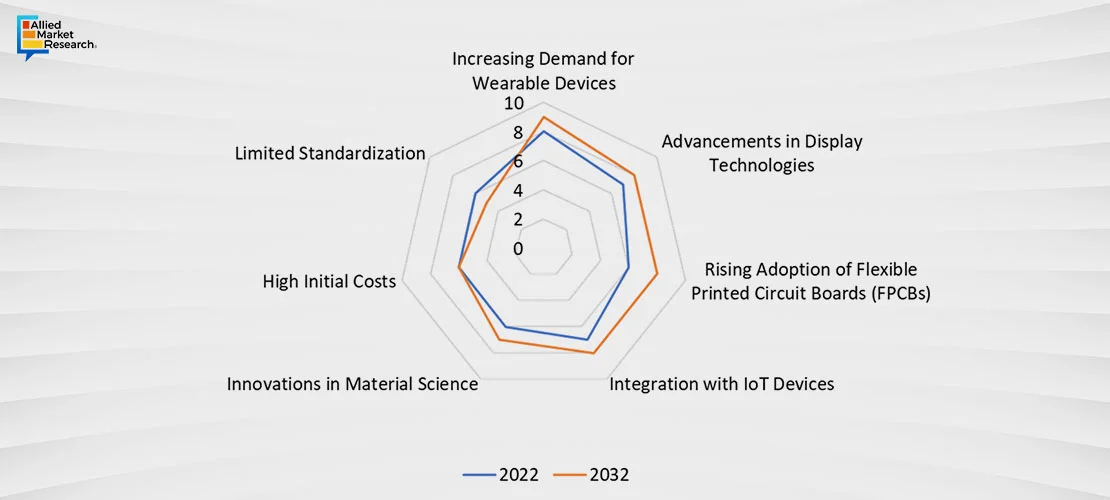Table Of Contents

Sonia Mutreja

Sumeet Pal
Pioneering the Future of Connectivity through Flexible Electronics Innovation

The flexible electronics market is witnessing a paradigm shift where devices are no longer confined by the limitations of rigidity but are expected to be adaptive, dynamic, and seamlessly integrated into various materials. The emergence of such a trend has increased the need for flexible electronics, marking a shift from the conventional and setting the stage for a new standard of connectivity.
The flexible electronics market growth is driven by increasing consumer demand for products that are slim, light, and versatile. More than ever, consumers are looking for items that fit into their lives organically, which is encouraging manufacturers to come up with innovative and feature-packed products. Flexible electronics' capacity to bend, fold, and stretch without compromising performance has spurred a surge of creativity, especially in the fields of displays, wearable technology, and medical applications. In addition to consumer-driven demand, advancements in material science have played a pivotal role. The development of flexible substrates, conductive polymers, and innovative manufacturing processes has catapulted the market into the limelight. These breakthroughs enhance the durability of flexible electronics and make them more cost-effective, paving the way for widespread adoption.

Top Impacting Factor
The flexible electronics market is thriving due to a convergence of technological advancements, increasing demand from various industries, and a focus on sustainability. As the market continues to evolve, stakeholders need to stay agile and innovative to capitalize on emerging opportunities and overcome existing challenges.
On the flip side, the initial costs associated with developing and producing flexible electronic components can be high. This includes investments in research and development, specialized manufacturing processes, and materials. The high entry barrier might limit market expansion. Furthermore, the flexible electronics industry's lack of standardized processes and materials can impede widespread adoption. Standardization is essential for interoperability and compatibility, and without it, businesses may face challenges in integrating different flexible electronic components into their products. Furthermore, the evolution of flexible electronics has not been without challenges. Issues such as manufacturing yield, scalability, and durability posed hurdles that demanded innovative solutions. However, the industry responded with a commitment to overcoming these challenges through collaborative research, technological resilience, and an unwavering dedication to pushing the boundaries of what is possible.
Major Trends
- Automotive Displays and Lighting: Flexible displays are finding applications in automotive interiors, and flexible lighting solutions are gaining traction. For example, OLED displays in car dashboards and flexible LED lighting systems for interior and exterior automotive lighting are becoming more prevalent.
- Internet of Things: Flexible electronics are being increasingly adopted in IoT devices for their adaptability and space-saving characteristics. For instance, smart clothing embedded with flexible sensors for tracking biometric data is an emerging trend in the IoT space.
- Wearable Electronics: Wearable devices have transitioned from novelty to necessity, driving the integration of flexible electronics. Wearables are no longer limited to smartwatches; they extend to smart fabrics, embedding flexible sensors to monitor biometric data, exemplifying a future where technology seamlessly integrates into our attire.
- Healthcare Applications: The healthcare sector is witnessing the integration of flexible electronics in medical wearables and remote patient monitoring devices. For example, smart patches with flexible sensors, like those used for continuous glucose monitoring in diabetic patients, represent a growing trend in healthcare applications.
These trends collectively demonstrate the diverse applications and growing significance of flexible electronics in various industries, showcasing the market's evolution towards more adaptable and innovative electronic solutions.

Conclusion
The flexible electronics market is not merely a reflection of current needs, but a projection of what technology can become—unobtrusive, flexible, and seamlessly integrated into our lives. As the market continues to evolve, its impact will resonate across industries, leaving an indelible mark on the way we experience connectivity in the years to come. Our team of experts at Allied Market Research is well-versed in all aspects of the smart technology and artificial intelligence industries, so our analysis goes beyond superficial observations. Our goal is to provide businesses with actionable intelligence so they can understand the current and future dynamics such as contributing factors, trends, and challenges in the flexible electronics market along with granular insights on segmental market sizing and forecasting at a country level. Allowing clients to take advantage of new opportunities, make wise decisions, and maintain an advantage in a cutthroat market.

